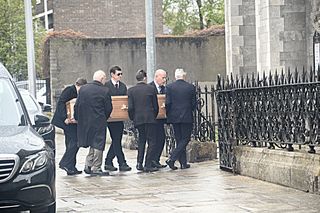Designer giving classic Dublin GAA jerseys a fresh and frilly twist



A Dublin designer’s new frilled sports clothing line, where “blokecore meets balletcore”, has garnered a growing fan base.
Sophie Murphy is on a mission to give new life to old clothing, but with a lacy twist.
She has been redesigning classic Dublin GAA jerseys and shorts by giving them one-of-a-kind features, all either by hand or her sewing machine.
Ms Murphy calls her business ‘Sewphie’ and reworks jerseys with lace trims and pretty bows.
She has turned Dublin jerseys into dresses and adds bows to O’Neills shorts, allowing people to wear sports gear with a stylish twist. But she isn’t just a GAA fan.
Some of her creations include a Liverpool jersey reworked with lace and ribbons, vintage Irish jerseys glammed up for St Patrick’s Day, and Real Madrid scarves with a feminine touch.
The quirky items are in high demand, with Ms Murphy having to launch stock drops online.
“All my pieces are created locally in Dublin by hand and on a machine,” she said.
Designer Sophie Murphy modelling her latest creation
“I source vintage GAA and soccer jerseys and rework each one using lace, ribbons and other fabrics, including textiles donated by friends and family, garments I no longer use and other sources.
“I first started ‘Sewphie’ when I left college. I studied fashion design at Grafton Academy and I decided I wanted to create my own label.
“I had interned with Simone Rocha and gained huge insight into the world of high-end fashion. I travelled to Tokyo and Seoul while in college and I saw a lot of opportunities in concept stores for young designers.
Read more
“However, I did find that there are few opportunities for young designers in Ireland, so I thought the best way to showcase my work was online.
“Both during and following on from the World Cup last year, we saw female footballers become the face of big brands and campaigns and also attend fashion week.
“Big brands such as BAPE designed the women’s Japan jersey, while Jamaica’s kit was designed by an English-based designer alongside Adidas.
“On the Jamaican kit, different textiles were used inspired by knitwear. I think this was a real turning point in the ‘blokecore’ trend.
“Taking something that was originally quite male-focused and playing with that, merging the two aesthetics.
We need your consent to load this Social Media content. We use a number of different Social Media outlets to manage extra content that can set cookies on your device and collect data about your activity.
“There’s the whole balletcore aesthetic, which is super feminine, it’s all about the bows and frills so I thought, what if I merge these two things together?
“Now, with my work there is such a strong demand for all counties, not just Dublin. I was shocked at how much the original reworked jersey took off and I decided to develop the range to include reworked O’Neills shorts too,” Ms Murphy added.
She understands the effects the fashion industry has on the environment and makes every effort to reduce waste in her production process.
Every piece is bought second-hand, lessening the demand for a new, high-polluting garment. It is locally sourced and reworked in Dublin.
The reworked clothing pieces are original and there will rarely be two items that are the exact same.
A classic Arnotts Dublin jersey given a new look by designer Sophie Murphy
She focuses on salvaging vintage garments that would otherwise end up in landfills, and all of the textile scraps are recycled and repurposed to eliminate waste.
“My self-declared mission is to give new life to old life,” Ms Murphy said.
“We understand the impacts the garment industry has on the environment and make every effort to reduce waste at each step of the production process.
“Every item takes a different amount of time to make as no two products are the same. I want my customers to feel like they are purchasing a unique item which they won’t see elsewhere.
“A rework is taking a pre-loved piece and making it new again. I think one of my main focuses is that my pieces tend to be quite trend-driven, which is something I am really keen on.
“Taking something old and making it on-trend again,” she added.
Join the Irish Independent WhatsApp channel
Stay up to date with all the latest news



















